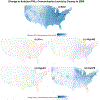Human Health Impacts of Energy Transitions across the United States among Sociodemographic Subpopulations for the Year 2050
- PMID: 40498102
- PMCID: PMC12288885
- DOI: 10.1021/acs.est.4c14326
Human Health Impacts of Energy Transitions across the United States among Sociodemographic Subpopulations for the Year 2050
Abstract
Strategies to reduce greenhouse gas emissions may provide health benefits through improved air quality, yet these benefits might not be equitably distributed. Understanding these cobenefits and who receives them can aid policymakers in prioritizing mitigation strategies. We investigated four future energy scenarios (port electrification, electric vehicles, natural gas, energy efficiency) and a business-as-usual scenario to determine how changes to ambient fine particle (PM2.5) levels impact health within the contiguous United States (U.S.) by region, race/ethnicity, urbanicity, and income. We also investigated how methodological assumptions affect findings. Our projections of avoided mortalities from energy transition policies range from 67,011 (95% CI: 45,692, 82,397) to 81,003 (55,286, 99,532) in 2050. The monetized health benefits from avoided mortalities and hospitalizations range from $785.8 billion to $949.9 billion/year. These benefits vary by region and subpopulation, with Black, suburban, and less wealthy Americans experiencing higher percent avoided mortality across scenarios. Results were sensitive to assumptions for future concentration-response functions relating pollution levels to health, baseline incidence rates, and population projections. Our findings indicate energy policies transitioning from fossil fuel production in the U.S. provide substantial health and economic benefits that vary across populations and help reduce environmental health inequities in exposure and associated morality.
Keywords: PM2.5; co-benefits; energy policy; environmental justice; exposure disparities.
Conflict of interest statement
The authors declare no competing financial interest.
Figures



Similar articles
-
Estimates of emissions from hydrogen transportation fueling infrastructure and vehicles.J Air Waste Manag Assoc. 2025 Jul;75(7):559-590. doi: 10.1080/10962247.2025.2495811. Epub 2025 Jun 16. J Air Waste Manag Assoc. 2025. PMID: 40327627 Review.
-
Effects of city design on transport mode choice and exposure to health risks during and after a crisis: a retrospective observational analysis.Lancet Planet Health. 2025 Jun;9(6):e467-e479. doi: 10.1016/S2542-5196(25)00088-9. Lancet Planet Health. 2025. PMID: 40516538
-
How Can the Environmental Impact of Orthopaedic Surgery Be Measured and Reduced? Using Anterior Cruciate Ligament Reconstruction as a Test Case.Clin Orthop Relat Res. 2025 Jan 1;483(1):7-19. doi: 10.1097/CORR.0000000000003242. Clin Orthop Relat Res. 2025. PMID: 39660662
-
Environmental exposure disparities in ultrafine particles and PM2.5 by urbanicity and socio-demographics in New York state, 2013-2020.Environ Res. 2023 Dec 15;239(Pt 2):117246. doi: 10.1016/j.envres.2023.117246. Epub 2023 Oct 6. Environ Res. 2023. PMID: 37806474 Free PMC article.
-
Air Quality Strategies on Public Health and Health Equity in Europe-A Systematic Review.Int J Environ Res Public Health. 2016 Dec 2;13(12):1196. doi: 10.3390/ijerph13121196. Int J Environ Res Public Health. 2016. PMID: 27918457 Free PMC article.
References
-
- World Health Organization. Global Health Observatory: Ambient Air Pollution Geneva 2024. https://www.who.int/data/gho/data/themes/topics/indicator-groups/indicat.... Retrieved September 1,
-
- Dockery DW; Pope CA; Xu X; Spengler JD; Ware JH; Fay ME; Ferrs BG; Speizer FE An Association Between Air Pollution and Mortality in Six US Cities. N. Engl. J. Med 1993, 329 (24), 1753–1759. - PubMed
-
- Pope CA; Dockery DW Health Effects of Fine Particulate Air Pollution: Lines that Connect. J. Air Waste Manage. Assoc 2006, 56 (6), 709–742. - PubMed
-
- Lu F; Xu D; Cheng Y; Dong S; Guo C; Jiang X; Zheg X Systematic review and meta-analysis of the adverse health effects of ambient PM2.5 and PM10 pollution in the Chinese population. Environ. Res 2015, 136, 196–204. - PubMed
MeSH terms
Substances
Grants and funding
LinkOut - more resources
Full Text Sources
Medical

